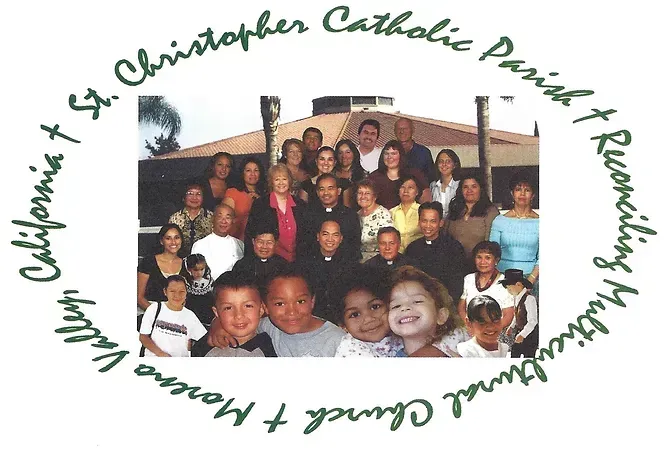Our History
St. Christopher parish was founded on October 6, 1957...
first pastor, Rev. John R. Domas
St. Christopher parish was founded on October 6, 1957, by its first pastor, Rev. John R. Domas (photo). The first Mass was said in a garage near the corner of Perris Boulevard and Sunnymead Boulevard. Known Catholics in the area then took a door-to-door census of the Moreno Valley area and recorded approximately 150 Catholic families.
For six months, services were held at the Edgemont Women’s Club Community Hall on Cottonwood Avenue near Highway 395.
As the parish grew, services were moved to John Descher’s “walnut shed” near the corner of Perris Boulevard and Highway 60.
It was during this stay that a search for a permanent location was initiated. After considering several properties, plans were submitted to Most Reverend Charles Francis Buddy, Bishop of San Diego, for a church to be built at the present location of Perris Boulevard and Cottonwood Avenue. With the approval of the Bishop, five acres of property were purchased for $9,000 in March of 1958.
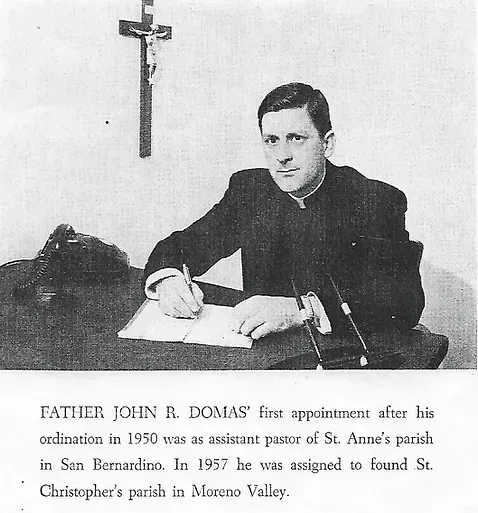
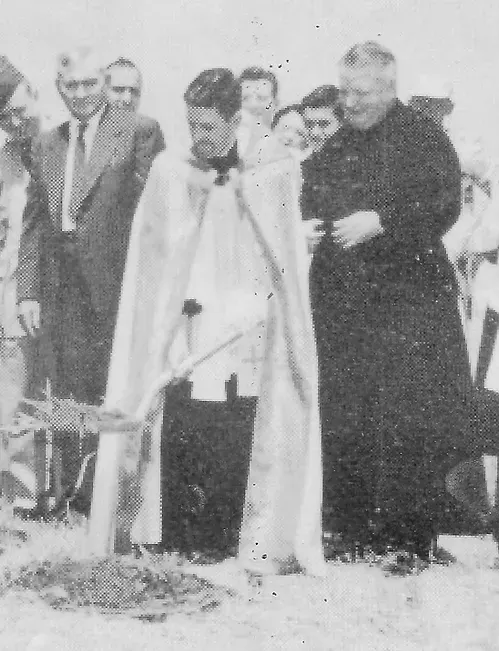
Ground breaking ceremonies June 1, 1958
Construction began the following day
Ground breaking ceremonies (photo) for the new church took place on June 1, 1958. Construction of the new church began the following day. Newell Baumunk supervised the parishioners who did a large part of the work. Personnel from March AFB also donated generously of their time. In addition, the ladies of the parish contributed significantly to the effort by serving lunch to the volunteer workers each Saturday during the six and one-half month construction phase.
The original construction was an “L” shaped building consisting of the church, a hall, and a rectory.
Seating capacity of the church was 300 with plans for “any future growth” being accommodated by seating for 150 more in the hall behind the altar.
The first Mass was celebrated in the newly built church on December 14, 1958. Gifts of vestments and other church furnishings were received from other parishes as well as the Catholic Church Extension Society. Plans for a parish school and convent began in 1963. A drive to raise $150,000 was headed by Fr. Domas and Mr. Frank Busche.
The school project was an ambitious effort
construction for the school
began on February 24, 1964
Considering the annual income for the parish was only $21,000 and $43,000 debt remained on the church, the school project was an ambitious effort. Faith triumphed, however, and construction for the school began on February 24, 1964. The land for the school was donated by Mr. Frank Busche.
The school was staffed by the Sisters of the Precious Blood from Dayton, Ohio. Their contract called for the sisters to be paid $100 per month. The sisters were housed in a four bedroom convent which presently serves as the rectory.
St. Christopher School consisted of grades one through six with two guides per classroom. Tuition was $10 per month per child. The school was closed at the end of the 1967-68 school year because the Sisters of the Precious Blood were forced to reorganize due to an insufficient number of sisters. The parish then rented the school rooms to the Moreno Valley School District, first for use as a continuation high school and later as an adult education center.
Rev. Lawrence N. Gatt, STD, succeeded Fr. Domas as pastor of St. Christopher parish on April 26, 1968. Fr. Gatt remained until February 5, 1971, when he was replaced by Rev. Thomas A Bolten. By this time, the parish had grown to 344 families and with 250 children enrolled in the CCD program. Parish organizations consisted of the Staffers Club, Holy Name Society and the Altar Society.
Fr. Thomas F. Meagher became pastor on May 1, 1972, replacing Fr. Bolten. Fr. Meagher’s report for 1973 indicated the ethnic makeup of the parish was 69 percent Anglo, 25 percent Black and 5 percent Oriental/Filipino.
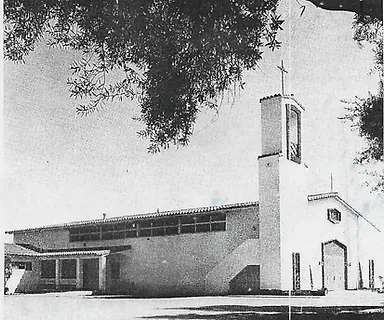
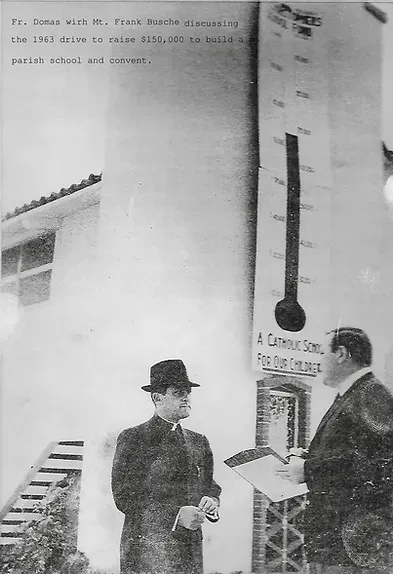
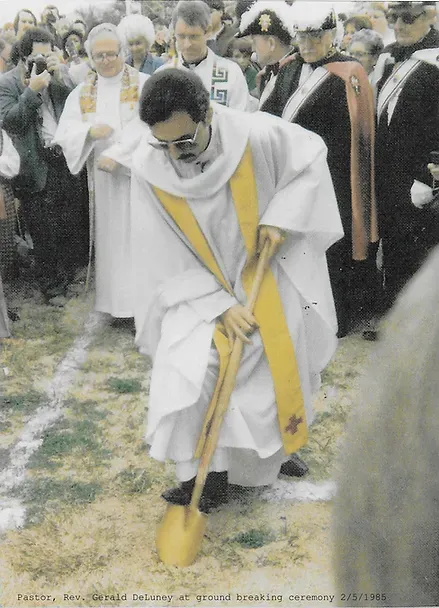
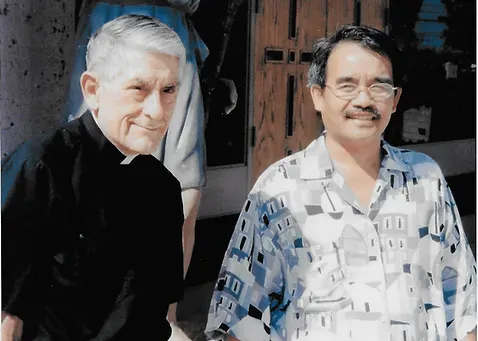
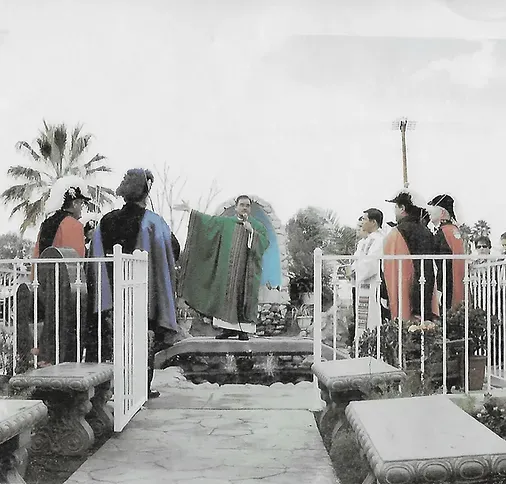
Acknowledging the need for a much bigger church...
Ground breaking for the 1,000 seat church took place on February 5, 1985
ev. Gerald DeLuney replaced Fr. Meagher on July 1, 1982. Acknowledging the need for a much bigger church, Fr. Gerry organized a planning committee and launched a pledge drive. The initial pledge drive resulted in pledges totaling $900,000 and allowed the construction phase to begin. Ground breaking for the 1,000 seat church took place on February 5, 1985. Thanks to the many fund-raising activities and the generosity of the parishioners, the construction debt of $1.4 million was paid off in less than three years.
The rapid growth of the parish required still another building project to accommodate those attending Mass and enrolled in CCD. Hence, in February, 1991, construction began to add 4,500 square feet and four classrooms to the main church building. The construction was completed during the fall of 1991 at a cost of $467,000 and brought the seating capacity of the church to 1,450.
Rev. Efren L. Musngi, M.S. of the Missionaries of Our Lady of La Salette replaced Fr. DeLuney in October of 1994. Rev. Romeo N. Seleccion, M.S. became the pastor in July of 2001. Rev. Joven Junio, M.S. became the pastor in July of 2008. Fr. Arnel Macabio, M.S. then succeded and is the present pastor.
Since its foundation to the present, there were significant changes; from 150 families to over 7,500 registered families at present; from a 300 seat church to 1,450 seat church; from a handful of CCD children to more than 2,000 children and youth in our Faith Formation Program; from a closed Catholic School to a new Pre-school; from a diocesan priests administration to a religious leadership.
A significant event inscribed in the history of St. Christopher Parish was the ordination to the episcopacy of Bishop Gerald Barnes on March 18, 1992. He is now the Ordinary of the Diocese of San Bernardino.
A religious community, the Missionaries of Our Lady of La Salette,
Ina Ng Pag-asa (Mother of Hope) Province, Philippines, took over the administration on October 1, 1994. The new leadership ushered in a paradigm shift in the areas of leadership, structures and programs. Participation of the laity in leadership roles became evident; ethnic communities were integrated in the parish’s structures; Hispanic ministry was reorganized; and bi-lingual services were encouraged in parish celebrations to affirm unity in diversity.
The parish, to refocus its direction, participated in the Planning Process conducted by the Diocese of San Bernardino. We identified our weaknesses and strengths, our needs and problems; and recognized that we were connected to one another. Then a VISION was articulated, which says:
“We, the faithful of St. Christopher Parish, animated by the GOOD NEWS of Christ and inspired by the DIOCESAN VISION, are called to grow as a RECONCILING MULTICULTURAL CHURCH.”
As the Parish journeys towards the Third Millennium, the constant prayer of the people is: “Thy Kingdom come, thy will be done, on St. Christopher parish as it is in heaven.”
